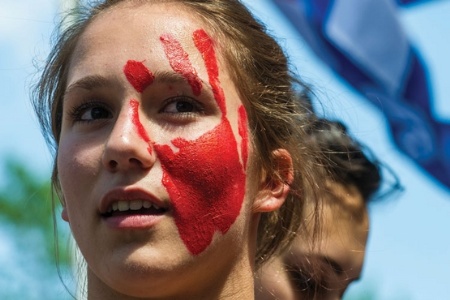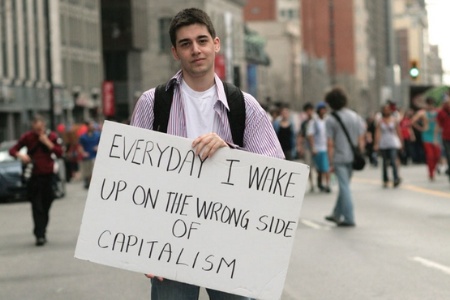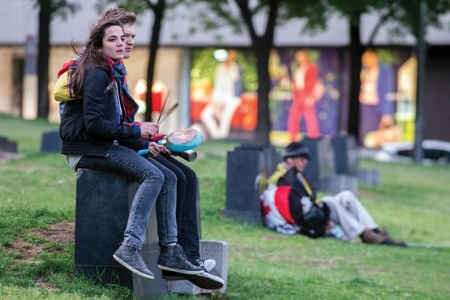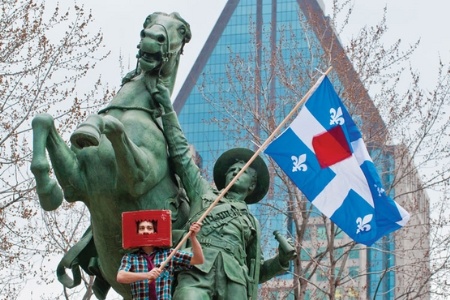Source: Getty
For students, the objective of securing a fees freeze was never entirely realistic. Nonetheless, ‘it wasn’t impossible and it was worth fighting for. We proved we can do something’
Cooling off in unseasonably hot weather in a cafe on rue Sainte-Catherine, Montreal’s main thoroughfare, students discussing 2012’s Quebec protests cannot quite believe the difference 12 months can make.
Last year was marked by a six-month student boycott, with university and college students refusing to attend classes, as well as two of the biggest marches in the province’s history. Night after night there were demonstrations, nicknamed les casseroles after the pots and pans local people banged and rattled in defiance of the government.
Looking out over the street, Elizabeth McPhedran, an anglophone master’s student at the francophone Université de Montréal, contrasts the sleepy vista with the scene a year earlier. She says she had grown used to falling asleep to the sound of police sirens blaring and helicopters whirring overhead.
“My parents back in Toronto kept asking: ‘Is it safe?’ All they saw on the TV were images of riots,” she says. “But that was such a tiny part of it. I was so proud to be there. It was so peaceful and happy in the streets, and so creative – the kind of thing that would never happen at home.”
The Printemps Érable (“Maple Spring”) may not have been on the scale of the Arab Spring from which it took its name. Yet prompted by the Liberal government’s attempt to increase the province’s university fees, then set at C$2,168 a year (£1,388), by 75 per cent over half a decade, the movement shook the province and led to the ousting of the ruling administration.
Today, students and politicians seem glad that the storm has passed, but the lasting effects of the “crisis” are less clear. The minority government that took power in September after the death of the Liberal administration is led by the Parti Québécois, the leaders of which stood shoulder to shoulder with the students just months before they were elected.
As the Parti Québécois had promised, one of its first actions was to halt the planned fee hike and withdraw Bill 78, a law introduced by the previous government in an attempt to quell the protests. The legislation, which outlawed demonstrations that had not been given prior approval by police, had backfired, serving only to draw greater public support to the students’ cause.
But after the pots and pans were put away, a long-awaited summit on post-secondary education was held in February and ended in a decision to index fees to living costs, meaning an increase of 3 per cent a year.
Meanwhile, in the face of a commitment to reduce Quebec’s deficit to zero by 2014, the government imposed a C$250 million budget cut over the next two years – and this to a university system rectors say is already chronically underfunded.
So while the protests helped to overturn a government that had been in power almost a decade and mobilised hundreds of thousands of people in the name of fighting fee rises, are students really any better off today?

Yes, according to Martine Desjardins, who until April was president of the University Student Federation of Quebec (FEUQ), an organisation which, through its member associations, represents more than 125,000 students and was instrumental in organising last year’s movement.
In an interview at the federation’s headquarters, a converted warehouse in downtown Montreal, Desjardins makes it clear that halting the 75 per cent fee hike was a big win. Although she concedes that the end result was “not exactly what we planned”, she insists that her group helped to achieve a number of significant concessions. She views the rise in fees and the cuts to university funding as negative elements of the government’s plans, which also include a commitment of C$1.7 billion in funding for higher education by 2019.
“We were part of the discussion and we got some victories out of it,” she says.
The positives include boosts to the student financial aid programme effective from next year, she adds. Desjardins is also pleased to see the creation of a series of working groups tasked with, among other things, updating laws on university governance and finance, and the creation of the National Council of Quebec Universities, a new representative group. A panel examining student grants and loans issued its conclusions on 14 May, including plans for the government to redirect C$25 million for the most disadvantaged students to help with food and housing costs. It also agreed to accelerate plans to help 7,000 more students access scholarships by raising the threshold for eligibility from a family income of C$28,000 a year to C$45,000, by 2015-16.
But what does the more militant wing of the movement, the Association for Student Union Solidarity (ASSÉ), think? Representing some 70,000 Quebec students on the platform of free education, it boycotted the summit. Jérémie Bédard-Wien, a spokesman for the organisation, does not see a victory of any sort: after all, a freeze in tuition fees “was the hope of 100,000 people just six months previously”, he points out.
For students such as Stephanie Sherrer, who is studying art history at the left-leaning, francophone Université du Québec à Montréal (where the vast majority of students boycotted classes), the objective of securing a freeze was never entirely realistic. Nonetheless, “it wasn’t impossible and it was worth fighting for”, she says. “The mobilisation proved we can do something.”
It is estimated that around a third of the province’s students went on strike. Sherrer believes she was lucky to be at her university at the time because most of its student associations voted for the strike and its teachers respected the boycott, leaving students free to attend pickets and protests.
In contrast, she has heard that at other institutions such as Concordia University, classes were cancelled only if under 50 per cent of the students turned up. Some students were left struggling with their studies after a vote to return to class in September, but Sherrer’s university adjusted its entire calendar to allow students to catch up.
While students have different views on the achievements of the Maple Spring, university rectors are united in the view that it has left a significant hole in their budgets. Ahead of the summit, the Conference of Rectors and Principals of Quebec Universities calculated that universities were working with a shortfall of C$850 million a year as a result of the province’s low fees when compared with institutions elsewhere in Canada.
François Lalonde, professor of mathematics and director of the Centre de Recherches Mathématiques at the Université de Montréal, says that institutions are already feeling the pinch, as evidenced by the rise in the number of chargés de cours – teachers who are paid by the course, rather than being salaried professors.

It’s all anyone talked about for six months and now people are tired of it. We want to have happy hour at the union and be able to chat with friends, whatever their opinions
Odile Marcotte, a colleague at the centre and adjunct professor at the department of computer science at the Université du Québec à Montréal, has also witnessed the effects of the lack of funding. She says that the number of scheduled tutorials is diminishing, student groups are larger and fewer postgraduates are being employed to help with practical classes.
“It seems clear to me that universities in the rest of Canada are richer than us. I think universities in Quebec are doing a good job, but if there is no increase in university funding whatsoever, we must see a decline in the future.”
“Fees were frozen in Quebec for a very long time at a very low rate: that meant the system was underfunded,” explains Heather Munroe-Blum, principal of the anglophone McGill University. As a result, there has not been enough student aid for those in need and the lack of funding has “made it very challenging for universities to perform their missions”.
At the summit, Munroe-Blum argued that cuts would have a major impact on jobs and services within the sector, as evidenced by Montreal’s École Polytechnique’s announcement that it would have to shut down fully equipped labs as a result of the cuts.
The cuts may be softened in part by a concession made by the government after the summit, allowing institutions to spread the load of the retrenchment over seven years rather than two. McGill was the only institution not to take up the offer. Speaking as the university works to find savings of C$43.5 million by 2014 to cover the cuts and fee shortfall, Munroe-Blum stresses that governments need to invest in and support universities in “a sustained, effective way”.
“You shouldn’t be whipsawed on what support you can expect from government,” she says.
But not everyone agrees that Quebec’s higher education system faces a dire shortage of cash. Yves Gringas, a professor at the Université du Québec à Montréal and Canada Research Chair in the history and sociology of science, argues that the quality of university education in the province is “excellent” and cites a recent survey of his institution’s graduates. It found that two years after they left, 90 per cent of students remained happy with the education and training they had received.
Calculations showing a comparative lack of funding in the sector fail to take account of differing costs of living in neighbouring provinces, he says. But more than that, he believes that such claims are based on false premises.
“The purpose of a university is to teach and carry out research. There’s no limit to this, so needs are infinite. So if you have a certain number of millions of dollars, you figure out that you pay professors this amount, and rectors another. We’re not there to compete.”
Although this view may run counter to the prevailing drive towards greater competition in higher education, students in the province tend to agree with him.

Antoine Genest-Grégoire, president of the FEUQ since 1 May, complains that “universities are asking for more money, but…we see them building campuses next to each other to try to lure students away, creating the exact same programmes as their neighbours”.
Genest-Grégoire hopes that the National Council of Quebec Universities will be able to take the first steps in moving universities towards cooperation and prompting greater economies of scale.
“We see this as looking first for better financing, rather than more financing just for its own sake,” he adds.
Most students who spoke to Times Higher Education say they recognise that universities lack funding in some areas but are not convinced that the existing money is always well spent.
Ninozka Marrder, a graduate student at the Université de Montréal, says she feels more passionately about the need for reform than she does about the need to preserve low fees. Administrative roles can be overpaid and over-resourced while money is also being wasted on marketing and red tape, she believes.
There seems no doubt that higher education will stay at the top of Quebec’s political agenda, even though the drone of helicopters and the clang of pots and pans are fading into memory.
Pierre Duchesne, the Parti Québécois’ minister of higher education, research, science and technology, says the summit was a new beginning rather than a conclusion.
“Yes, it was the end of the social crisis, but it was the start of a range of important reforms in higher education,” he argues.
Despite the challenges of public financing, Duchesne is adamant that the Parti Québécois-led government wants to increase access and student numbers while improving teaching quality.
Future government investment will be targeted at improving research and fostering philanthropy, and 1,000 extra professors will be hired “in the coming years”, an increase of 10 per cent, he says.

A focus on research and graduate students is something every higher education group – from the most radical students to university rectors – agrees is a priority. Quebec is one of the only provinces in Canada to have its own funding council and Duchesne says his ministry is currently writing a national policy to increase investment in research to 3 per cent of gross domestic product, up from an already impressive 2.4 per cent.
Meanwhile, Genest-Grégoire says that the FEUQ is looking forward to tackling issues such as loans and scholarships, student working and debt without a “gun to its head”, as he describes the situation when students were faced with steep tuition fee rises.
Even the ASSÉ, which organised a 10,000-strong demonstration at the conclusion of February’s summit in favour of free higher education, agrees that “the parentheses of the Maple Spring have closed”, as Bédard-Wien puts it. “You can see from looking outside – there are not a lot of protests, just a lot of people resting in the sun.”
The issue of how long the peace will last will largely depend on how the politics plays out. Genest-Grégoire says that the Parti Québécois has so far been more receptive and open to dialogue than its predecessors in power, but as a minority government its position is inherently unstable.
At the next provincial election, whenever it comes, Desjardins believes that the lasting memory of the 2012 protests is likely to prevent any party proposing a fee increase at the scale or speed of the previous plans, adding that even the indexation policy may yet hurt the Parti Québécois at the polls.
“It knows right now that the movement isn’t as mobilised as it was – but it knows what can happen,” she says.
For now, students seem to be tired of protesting and are relishing being back in class and getting on with their lives.
“It sounds weird to say, but [striking] is really demanding and takes a lot of energy from students and teachers,” says Marrder. “It’s all anyone talked about for six months and now people are tired of it. We want to have happy hour at the union and be able to chat with friends, whatever their opinions.”
But this does not mean that activists in the province’s universities will stop pursuing free education, she adds – and if anywhere is to succeed in turning back the tide of rising tuition costs, it may be Quebec.
elizabeth.gibney@tsleducation.com
Protest movement: ‘Maple Spring’ timeline
- 17 March 2011 Quebec’s government publishes A Fair and Balanced University Funding Plan as part of the provincial budget, formalising proposed increases to fees.
- November 2011 Students across Quebec begin to demonstrate in opposition to the increases.
- 13 February 2012 Strikes begin in colleges and universities.
- 22 March 2012 The first of two huge marches, with an estimated 200,000 people demonstrating and a similar number of students on strike.
- 14 May 2012 Negotiations with students collapse and education minister Line Beauchamp resigns.
- 18 May 2012 The government passes Bill 78, which restricts protest without prior police approval and brings forward students’ summer holidays in an effort to manage the demonstrations.
- 22 May 2012 Hundreds of thousands of people take to the streets in protest.
- 24 May 2012 Casseroles, noisy demonstrations by local people with pots and pans, spread to most Montreal neighbourhoods.
- 1 August 2012 Liberal Party Premier Jean Charest calls an election, asking for the “silent majority” to restore him to office on a law and order platform.
- 4 September 2012 The Parti Québécois, led by Pauline Marois, forms a minority government following the provincial election.
- 26 February 2012 Summit on post-secondary education concludes with the decision to index tuition fees to inflation.
Solidarity under the red square banner: how Quebec students succeeded where others failed
Even if Quebec’s tuition fees had risen by 75 per cent over five years, they would have remained below the Canadian average.
When the provincial government tried to introduce the measure, it said the rise would reverse a long-term decline in fees relative to inflation, restoring them to the equivalent of the sums charged in 1968.
Yves Gringas, professor at the Université du Québec à Montréal and Canada Research Chair in the history and sociology of science, says that the proposals seemed reasonable to many elsewhere in the world. “Globally they say: ‘Those Québécois are crazy, prices should double!’ But here they say ‘You’re crazy to pay what you do’.”
Quebec’s radical traditions stem from its cultural ties to France and date back to the “Quiet Revolution” in the 1960s, when the francophone majority in the province made huge strides in opening up access to higher education, creating the federated Université du Québec as well as the collèges d’enseignement général et professionnel system (Cégep), also known as general and vocational colleges.
Originally set at C$540 a year in 1968, fees were frozen until 1991. This was a deliberate attempt to bring the already small cost of education down to zero through inflation, says Stephan Fogaing, a student at Montreal’s École Polytechnique. The costs were to be covered by corporate and personal tax revenues instead.
From the 1990s, fees crept up to C$2,168, but students fought the rises at each stage.
Past successes created “a strong feeling that we’re protesting and striking to ensure that what we’re given by the previous students, we’re giving to the next generation”, says Antoine Genest-Grégoire, president of the University Student Federation of Quebec (FEUQ).
In the province, students are an important part of the political landscape and politicians have to listen to them, says former FEUQ president Martine Desjardins.
“Here, it’s an outrage if we’re not at the negotiating table. If you complained of the same in another country, people would laugh at you.”
But the student movement, under its carré rouge banner – a simple red felt square that was seen pinned to the breast of everyone from opposition politicians to members of the Montreal-based band Arcade Fire – also seems to have succeeded because it became a symbol for many other issues.
Backed by the media and unions, the protests united those opposed to public service cuts and angry with the government and corporate greed, says Heather Munroe-Blum, McGill University’s principal.
Although Munroe-Blum wanted fees to rise, she says the period of unrest also made her think that “this is what democracy is all about, and it was very positive and very effective”.
While social media helped to build momentum, as did the government’s failure to reach an agreement with students, the protests also captured a wider national mood.
And the draconian Bill 78 only served to elicit even greater public support for the movement, says Desjardins.
“Bill 78 was like the government was playing a king on a four. It used this special bill to attack and to confront the student movement – but it was left with a population so angry that they ended up going out protesting every night for a month.”
François Lalonde, director of the Université de Montréal’s Centre de Recherches Mathématiques, observes that in Quebec, students “don’t want to pay or have an entrance exam. The rules are that every programme must be accessible to everybody. But this ideology is not what happens in France or the US.”
At some point, he suggests, its system will have to give.
Register to continue
Why register?
- Registration is free and only takes a moment
- Once registered, you can read 3 articles a month
- Sign up for our newsletter
Subscribe
Or subscribe for unlimited access to:
- Unlimited access to news, views, insights & reviews
- Digital editions
- Digital access to THE’s university and college rankings analysis
Already registered or a current subscriber?




